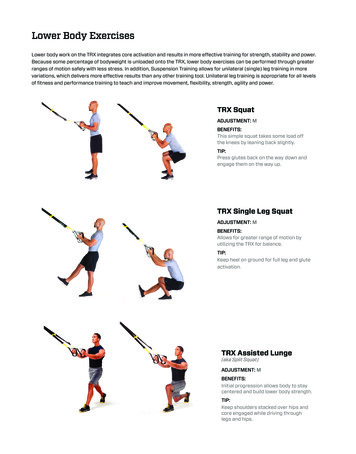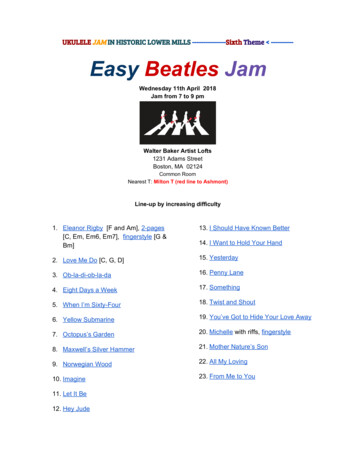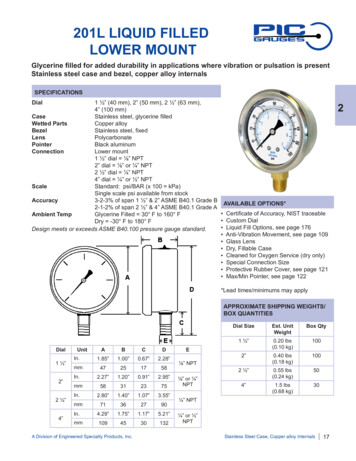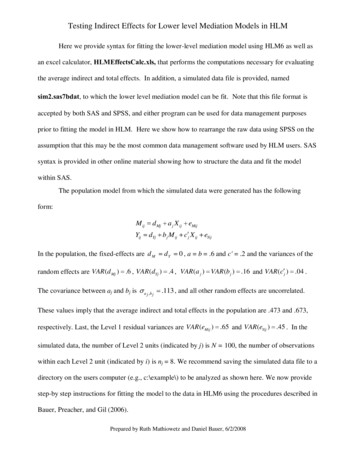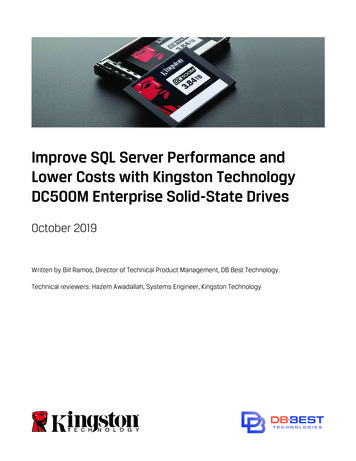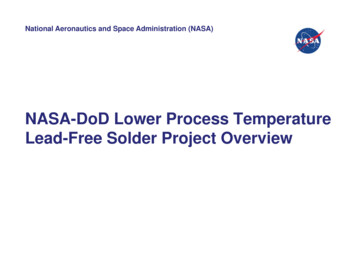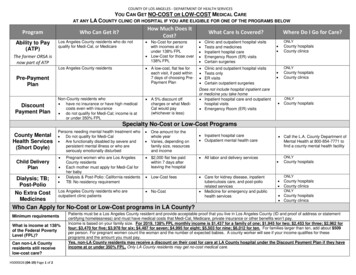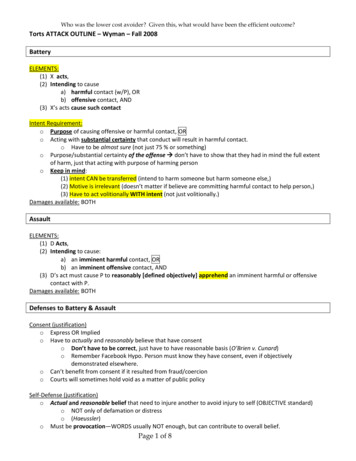
Transcription
Who was the lower cost avoider? Given this, what would have been the efficient outcome?Torts ATTACK OUTLINE – Wyman – Fall 2008BatteryELEMENTS:(1) X acts,(2) Intending to causea) harmful contact (w/P), ORb) offensive contact, AND(3) X’s acts cause such contactIntent Requirement:o Purpose of causing offensive or harmful contact, ORo Acting with substantial certainty that conduct will result in harmful contact.o Have to be almost sure (not just 75 % or something)o Purpose/substantial certainty of the offense don’t have to show that they had in mind the full extentof harm, just that acting with purpose of harming persono Keep in mind:(1) intent CAN be transferred (intend to harm someone but harm someone else,)(2) Motive is irrelevant (doesn’t matter if believe are committing harmful contact to help person,)(3) Have to act volitionally WITH intent (not just volitionally.)Damages available: BOTHAssaultELEMENTS:(1) D Acts,(2) Intending to cause:a) an imminent harmful contact, ORb) an imminent offensive contact, AND(3) D’s act must cause P to reasonably [defined objectively] apprehend an imminent harmful or offensivecontact with P.Damages available: BOTHDefenses to Battery & AssaultConsent (justification)o Express OR Impliedo Have to actually and reasonably believe that have consento Don’t have to be correct, just have to have reasonable basis (O’Brien v. Cunard)o Remember Facebook Hypo. Person must know they have consent, even if objectivelydemonstrated elsewhere.o Can’t benefit from consent if it resulted from fraud/coerciono Courts will sometimes hold void as a matter of public policySelf-Defense (justification)o Actual and reasonable belief that need to injure another to avoid injury to self (OBJECTIVE standard)o NOT only of defamation or distresso (Haeussler)o Must be provocation—WORDS usually NOT enough, but can contribute to overall belief.Page 1 of 8
Who was the lower cost avoider? Given this, what would have been the efficient outcome?ooMust be imminent—unless it reasonably appears there will be no later opportunity to prevent thedanger.Can only use proportional force. (Haeussler)o Don’t have to retreat from home BUT still must use only proportional forceIntentional Infliction of Emotional Distress (IIED)ELEMENTS:(1) Extreme and outrageous conduct, AND(2) D must act intentionally or recklessly to cause the severe emotional distress, ANDo Reckless—D must be aware and consciously disregard a substantial riski. Risk—gross deviation from SOCii. Doesn’t have to be aimed at specific persono Intentional—intent is NOT transferable has to harm the person aimed at(3) Must cause such distresso Don’t need professional evidence BUT do have to prove (Littlefield)Damages available:o Compensatory (NO punitive damages compensatory already kinda are)NOTICE: for assault all have to prove is apprehension BUT here you have to show severe emotional distressTrespassIntentional invasion of another’s land w/o that owner’s consento No knowledge requirement liable even if you thought it was your lando “invasion”—something w/in your control (you, water, animal) has to go on the lando Only owner or possessor can bring actionDEFENSES?(1) PRIVATE NECESSITY (Vincent v. Lake Erie Transport Co.)o P can’t evict,o and can be held liable for damage caused in course of doing soo BUT D must pay for damage(2) Did P CONSENT to allow D to use her land?o What was the nature of that consent?o What was the scope of that consenRespondeat SuperiorA public or private employer is liable for its employees’ actions that fall within the scope of their employment(Wall-Mart Stores, Inc.)Strict LiabilityProves entire claim EXCEPT for ultra-hazardous activities, then just proves breachPage 2 of 8
Who was the lower cost avoider? Given this, what would have been the efficient outcome?NEGLIGENCE Misfeasance (easy—history of recognizing duty) v. nonfeasance (hard—not well-established)(1)(2)(3)(4)(5)Injury—physical or financialDutyBreach (of requisite standard of care)Causation—(a) causation in fact; AND (b) proximate causeDefensesDoes P have standing to sue?oooIs P alleging injury to her/himself?Is P the next of kin or estate of a decedent upon whose behalf they’re suing? If so, then go onto establishthe rest of the elements as they apply TO THE DECEDENT!Is P alleging D’s employee injured him? Respondeat SuperiorINJURY CHECKLIST:1. Is the injury to person or property? keep going2. Is the injury for lost income? pure economic loss! [FILED UNDER DUTY IN OUTLINE!!!]a. No recovery UNLESS odd circumstancesi. Natural resource cases w/o cause of actionii. Tied reasonableness of different physical risk (People Express)iii. Special relationship, where professional opinion is relied upon (auditor, lawyer)3. Is the injury Emotional? NIED [FILED UNDER DUTY IN OUTLINE!!!!]a. Parasitic on physical claim damages for (‘pain and suffering’)b. Pure and unrelated to person/property injury? keep goingi. Pass the zone of danger test? recovery (Gottshall)1. Physical manifestation of emotional damage (e.g. shakes)2. Reasonable fear of physical danger leads to emotional damageii. Bystander? recover if1. Reasonably foreseeable that accident would cause distress2. Proximity to accident (Thing, La Chusa)DUTY CHECKLIST: (yes or no and what gives rise)1. Questions checklist:o Did the conduct create a risk of physical harmo Did an actor voluntarily assume a dutyo Is there a special relationship such that a duty is conferred on a third party?o Did negligence invite a rescue?o Did property cause the injury?o Is the bad actor a government agency?o THE BIGGIE: IS THERE A POLICY REASON FOR THERE NOT TO BE A DUTY?Page 3 of 8
Who was the lower cost avoider? Given this, what would have been the efficient outcome?1. Did the conduct create a risk of physical harm? Duty of reasonable carea. No privity needed (McPherson)b. Foreseeability of injury can imply duty (Mussivand)2. Did an actor voluntarily assume a duty? continue once started3. Is there a ‘special relationship’ Affirmative duty to rescue/protect third party [R3T 41]a. Parent w/ dependent kids (Applehans neglilgent parenting)b. Custodianc. Employerd. Mental Health Pro. (Tarasoff, Ewing)e. Social Host -- Rarely (Kelly)4. Did an actor’s negligence create the need for a rescue? Rescuersa. Negligence towards victim duty to rescurei. “Danger invites rescue” (Wagner)b. Low contributory negligence standardc. Is it this person’s job to rescue? firefighter rulei. No recovery5. Was someone injured by the condition of a property? Premises liabilitya. How categorize?i. Trespasser: no willful/wanton injury1. know of regular? duty to warn2. children who can’t appreciate danger duty to warnii. Licensee duty to warniii. Invitee reasonable careiv. DON’T FORGET TO MENTION ROWLAND!b. Concealed trap? duty to warn regardless of status6. Is the bad actor a government agency? public duty ruleBREACH CHECKLIST: (what was the standard of care owed and was it breached?)Reasonable Person Standard—Would a reasonable person of ordinary prudence, in D’s position, have conductedthemselves as D did?1. Was the person a child?a. Under 18 Reasonable child standardi. Under 5 Tender Years doctrineii. DON’T FORGET NEGLIGENT PARENTING *Applehans]2. Was there a physical disability?a. IF so reasonable person w/ that disabilityb. NOT TRUE for insanity; the insane are liable for their torts [Wagner]3. Use the Hand Formula to measure Reasonable Behavior?a. Hand Formula helps B PL no liability [Caroll Towing]Page 4 of 8
Who was the lower cost avoider? Given this, what would have been the efficient outcome?i. Layman’s terms: If the cost of prevention is higher than the increased probabilitytimes the cost of the bad event, then the preventative measure isn’t worth it.4. Did the Defendant follow industry custom?a. If so negligence is less likely [TJ Hooper]b. Posner: Especially determinative if an indication of market risk allocation [Rodi Yachts]5. Is this a professional malpractice case?a. If so industry custom is determinativei. Subject to the respectable minority ruleb. Medical malpractice: Is there informed consent?i. Prudent patient standard: What a reasonable patient would want to knowii. Reasonable physician standard: basically industry custom6. Was a statute violated?a. If so negligence per sei. D violated statuteii. Statute designed to protect against the type of accident causediii. Victim w/in class to be protectediv. No ‘excuse’1. Incapacity: childhood, disability, etc2. Reasonable care to try and comply3. Doesn’t/shouldn’t know of facts that make statute apply4. Statute confusingly presented to public5. Compliance result in greater risk of harm than nonConditions for Imposing Res Ipsa: Flour case is paradigm!!!(1) Injury must be of a type that doesn’t occur w/o negligence (Injury has to more probably than not resultfrom negligenceo Strong limiting condition(2) D must be in exclusive control of the harm-causing instrumentalityo D must be the one you can clearly point to as being responsibleo May or may not be able to invoke against multiple Ds(3) P must not have been responsible for or an active participant in the injuryo Another way of stating 2---if P is active participant, D could not have been in exclusive control.ACTUAL CAUSE CHECKLIST:1. But-For Test: But-For D’s action, would P have been injured?a. D must actually be proven a cause, not just one possibility among others (Skinner)b. Did D’s actions increase the risk of harm to P? (Beswick—private ambulance) YES—up to jury todecide whether risk was a substantial factor in producing the harm.2. Is there scientific evidence? Daubert Testa. Testimony reliable?b. Testimony grounded in scientific evidencePage 5 of 8
Who was the lower cost avoider? Given this, what would have been the efficient outcome?3. Are there multiple tortfeasors/causes?a. Was each cause necessary for the harm? joint and several liabilityi. Eg: two cars crash, then hit pedestrianb. Was each cause sufficient for the harm? substantial factor testi. E.g.: Two fires from opposite ends of town burn building [Anderson]c. Is market share liability appropriate?i. Only in DES cases!ii. Good must be fungible! [Skipworth]d. Alternative liability: multiple tortfeasors, don’t know which onei. RESULT: burden of proof shifts to Dii. E.g.: Shotgun to the face case [Summers]iii. 4 part test1. P sues multiple actors2. P proves each actor exposed P to risk of physical harm3. P proves that one or more of D’s caused the harm4. P can’t reasonably be expected to prove which D caused the harmPROXIMATE CAUSE CHECKLIST:1. Four Testsa. Foreseeability Test: Was the injury one that could be reasonably foreseen?b. Risk Rule: was the injury the realization of a risk that made the D’s action wrongful?i. [R3T §29]c. Directness Test: Was the defendant close in space/time? [OUT OF FAVOR]d. Grab Bag: Some combo of the above.2. Is there an intervening or superseding cause?a. Unforeseeable event different from what D should have anticipatedi. Gathering gunpowder; intervening cause [Pollard]ii. Found hidden dynamite; not intervening [Clark]DEFENSES CHECKLIST:(1) Was P acting negligently also? (Same reasonable person standard)o Comparative fault? REDUCES RECOVERY (may bar it too)o was P more or less than 50% negligent?o Baldwin—YES get nothingo Contributory negligence BARS RECOVERY (but not so common to see this now)(2) Is there a way to argue P assumed risk? ABSOLUTE BAR on RECOVERYo Explicit? (If so, is this void for policy reasons?)o Implicito Actually knew of (particular) risko Voluntarily consented to bear that risk NOT necessarily fulfilled b/c deliberately encounter danger (j-walker) Protest, but then go anyway?o 3rd Restatement this is obsoleteo NO implicit assumption where there’s duress (were P had no reasonable choice)(3) Is there a way to argue that D has some sort of immunity?Page 6 of 8
Who was the lower cost avoider? Given this, what would have been the efficient outcome?DAMAGES CHECKLIST: Use your outline.(1) Is D entitled to punitive damages? (National By-Products—common law test)o NOTE: Don’t need malice on D’s part BUT Negligence not sufficient—need more than simple carelessnesso Was D unaware his conduct was dangerous? Wanton disregard (ower threshold)—D need not know BUTo Conduct must pose grave dange;r ANDo D had reasons to know of dangers of conducto Was D aware her conduct was dangerous? Conscious indifference—o D is aware his conduct creates a risk of injury; ANDo That risk is substantially larger then necessary than the risk required to make the conductcareless.o Guideposts:o degree of reprehensibility of D’s conducto disparity b/t actual and potential harm sufferedo difference b/t punitive damage awards by jury and civil penalties available for same wrongdoing.o See long outline pg. 29 for guidelines for reviewing these awards(2) Has P already gotten any money? Collateral Source Rule Reduce total award by that amount, then go to (3)(3) Did D’s employee cause the damage (and not D directly?)—Respondeat Superior—(scope of employmenttest)—Can risk fairly be regarded as typical (or broadly incidental) to enterprises undertaken by employer?(4) Are there multiple D responsible?YESo Indivisible injuryo If the parties were working concurrently or in concert (both were needed for injury to occur) joint and several liabilityo POLICY NOTE: If you argue J&S is possible, you should note that many states are backing awayfrom this and suggest that it might be possible to see fault as divisible and award proportionaldamages—though we may not know which parts of the injury were caused by whom, we maybe able to tell who was more negligent divide accordinglyo Divisible injury—apportion damages accordinglyNO—whoever’s responsible must pay(5) Was P comparatively at fault?o YES—reduce P’s damages proportionatelyo Say if was contributory negligence D wouldn’t have to payo Say if were divided damages situation
Torts ATTACK OUTLINE – Wyman – Fall 2008 Battery ELEMENTS: (1) X acts, (2) Intending to cause a) harmful contact (w/P), OR b) offensive contact, AND (3) Xs acts cause such contact Intent Requirement: o Purpose of causing offensive or harmful contact, OR o Acting with substantial certainty that conduct will result in harmful contact.


